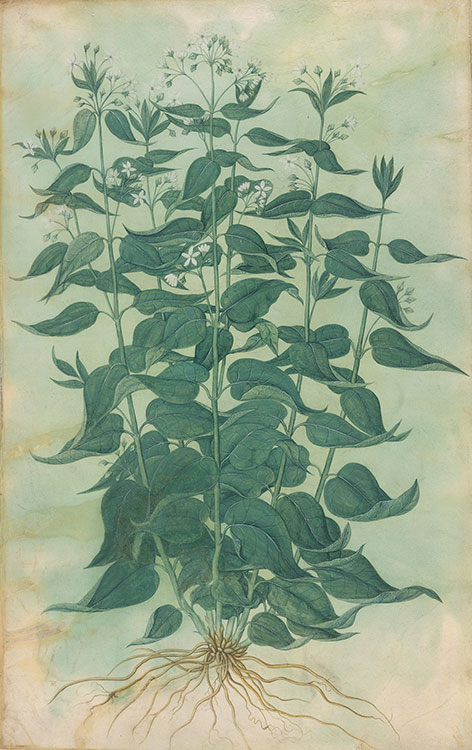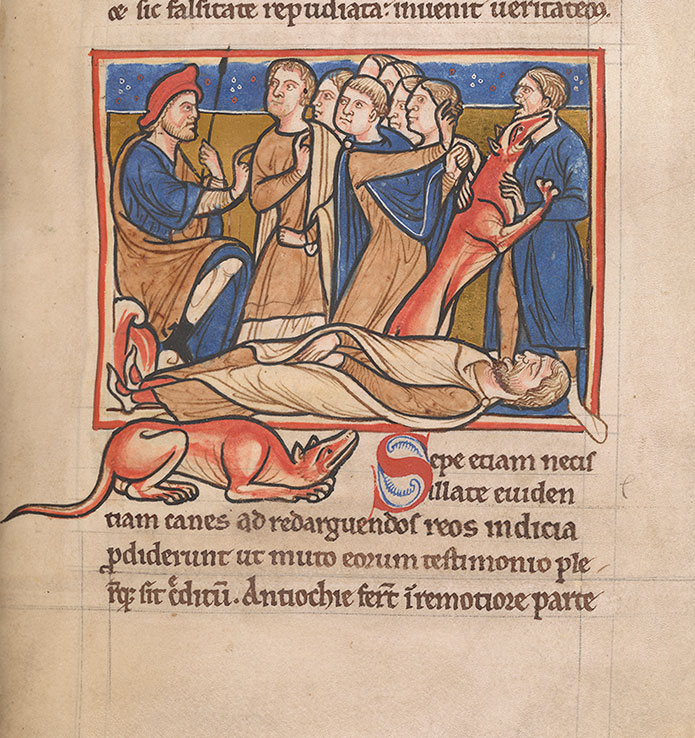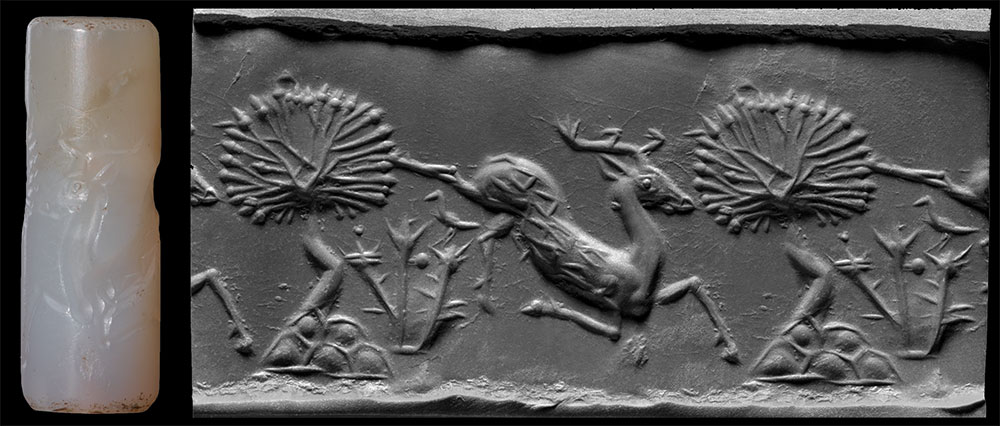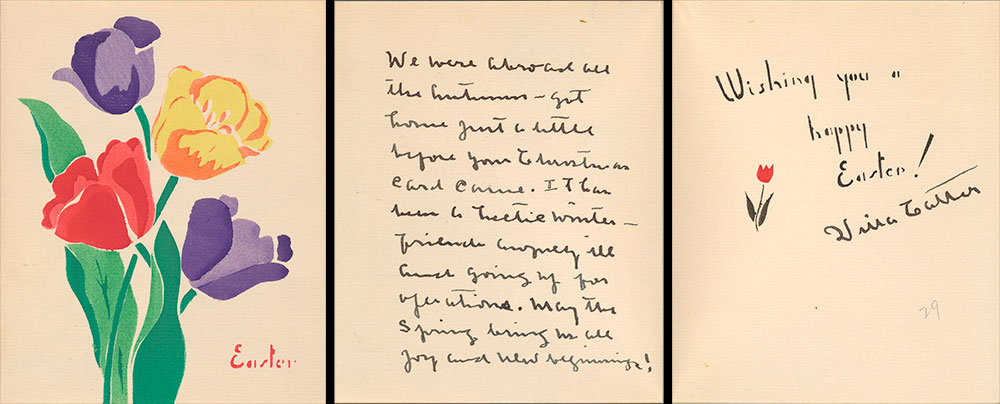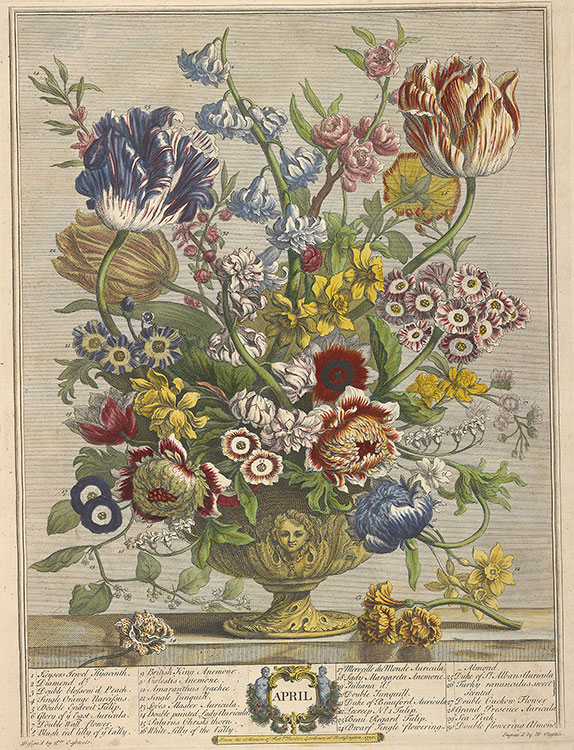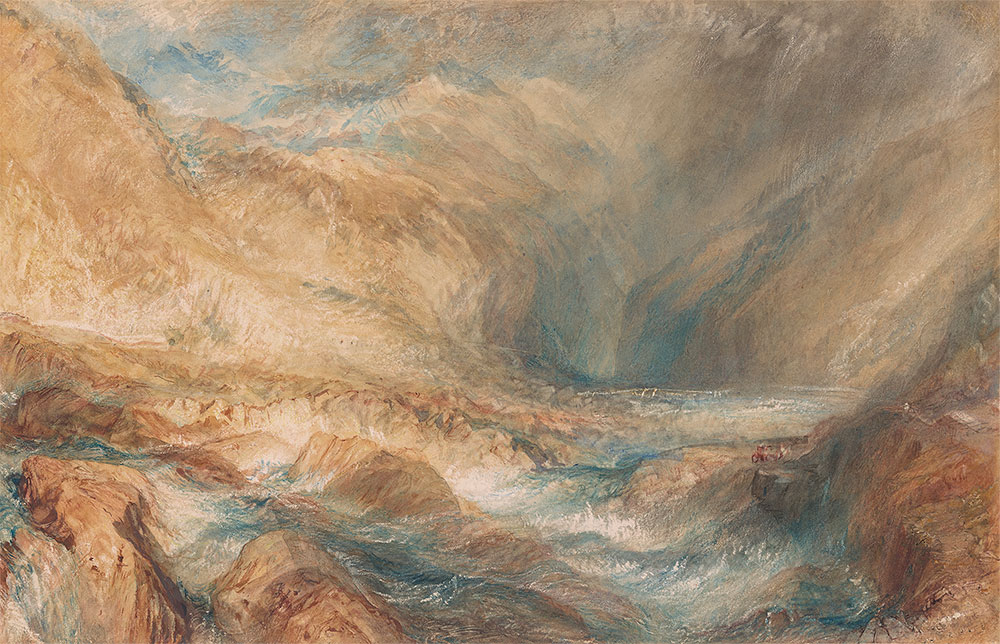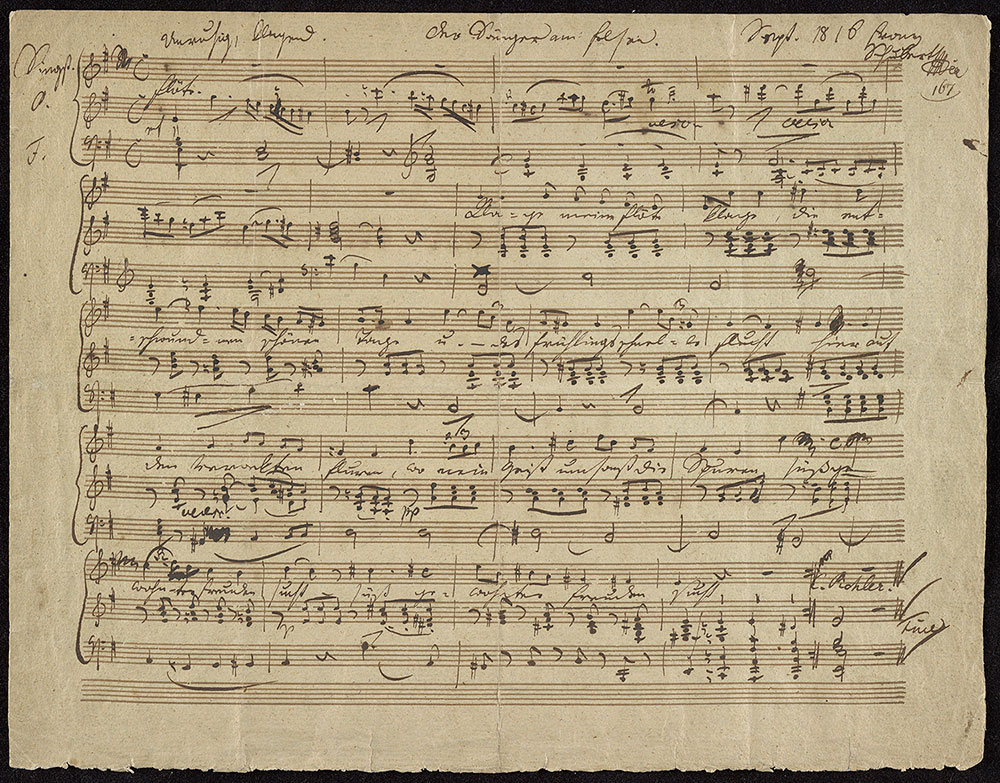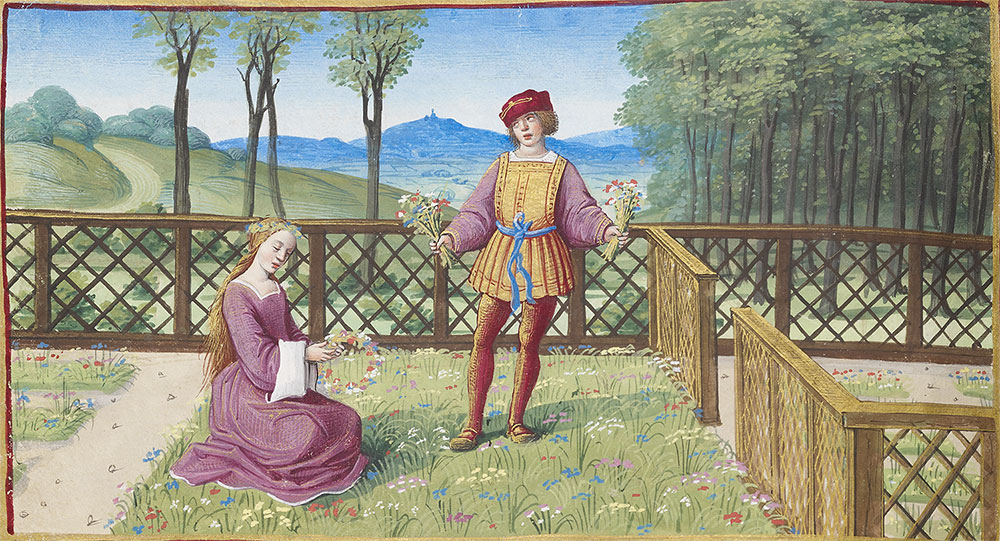Morganmobile: Spring(ing)
The very name of spring describes what it’s about: bouncing out, rebounding, thawing out the wellsprings and letting what’s new spring forth. What comes next? That’s another season’s business; spring is just about springing.
Morganmobile: Spring(ing)
Springing into three dimensions at the center of Topiary are seven snack peas, laid in a row upon a photograph in a magazine. For her ongoing series Seat Assignment, Nina Katchadourian obliges herself to treat the hours she spends on commercial flights as studio time: art-making is mandatory. Besides her phone camera and a couple of basic tools in her carry-on, her art supplies are limited to what she finds in the seat pocket and what the flight attendant provides, such as a straw, a napkin, or the contents of a sugar packet. Topiary finds Katchadourian making the best of a familiar circumstance: in the seasonless, indifferently lit setting of an airplane cabin, the anodyne pages of the in-flight magazine assume out-size visual importance.
Nina Katchadourian (b. 1969), Topiary, 2012, from the series Seat Assignment. Digital chromogenic print, 24 x 19 inches. Purchased on the Charina Endowment Fund; 2019.137.
Morganmobile: Spring(ing)
Jacopo Ligozzi’s carefully observed, minutely rendered watercolor depicts a white swallow-wort, a perennial herbaceous plant whose root was used as a medicinal emetic. In 1577, Ferdinando I de’ Medici, the Grand Duke of Tuscany, invited the Veronese-born Ligozzi to Florence. As a court artist, Ligozzi made comprehensive illustrations of the flora and fauna in the Medici gardens at Florence and Pisa. The drawing, its background unadorned by the artist, may have sustained accidental water damage that caused the green pigment to bleed into the parchment, transplanting this herbal specimen to an unintentionally verdant setting.
Jacopo Ligozzi (1547–1627), A Botanical Specimen of Vincetoxicum Officinale, ca. 1577–87. Watercolor, opaque watercolor, over black chalk, on parchment; 21 1/4 x 13 1/4 inches (540 x 337 mm). Gift of Dr. Werner Muensterberger.
Morganmobile: Spring(ing)
As described in medieval bestiaries (books of beasts), dogs are the cleverest animal of all: perceptive creatures that recognize their own names and love their owners. Underscoring canine loyalty and intelligence, this image shows a faithful dog grieving for his murdered master, then springing up to identify and apprehend the murderer. The moral is clear: although sinners may be able to hide their evil deeds from other people, God and his creatures will discern the truth.
Worksop Bestiary, England, possibly Lincoln or York, ca. 1185, Purchased by J. Pierpont Morgan in 1902; MS M.81, fol. 28r.
Morganmobile: Spring(ing)
The artist who carved this stag—its antlered head proudly held high, its forelegs poised to land—must have been familiar with the extraordinary grace and dignity of the animal, whose name, lulimu, could also mean “ruler” or “prince.” The significance of the scene in the context of this seal is unknown. However, a suggestive passage is found in a biblical text from the Song of Solomon (2:8–9), in which the bride speaks of her bridegroom: “The voice of my beloved! Behold, he cometh leaping upon the mountains, skipping upon the hills. My beloved is like a roe or a young hart.”
Ancient cylinder seal with modern impression: Leaping Stag with Tree on Mountain. Mesopotamia, Middle Assyrian period (ca. thirteenth century B.C.). Chalcedony; 1 3/16 x 3/8 inches (3 x 1 cm). Acquired by Pierpont Morgan sometime between 1885 and 1908; Morgan Seal 601.
Morganmobile: Spring(ing)
In 1936, American novelist Willa Cather sent this colorful Easter card to her friends Harriet Fox Whicher and George Frisbie Whicher, English professors at Mount Holyoke and nearby Amherst College. Inside, Cather wrote a brief message in her distinctive hand: We were abroad all the autumn – got home just a little before your Christmas card came. It has been a hectic winter – friends awfully ill and going up for operations. She may have been alluding to the devastating news that her beloved friend Isabelle McClung Hambourg had recently been diagnosed with inoperable kidney disease. Still, Cather expressed the hope many of us summon as we emerge from a season of grief or pain: May the spring bring us all joy and new beginnings!
Willa Cather (1873–1947), Easter greeting card by Norcross Studio Designs with autograph note to George F. Whicher and Harriet Fox Whicher, [1936]. Gift of Mrs. George F. Whicher, 1965; MA 2419.29.
Morganmobile: Spring(ing)
As indicated by the inscription “maius” in the lower margin, this idyllic drawing represents the month of May, offering up a vision of worldly, mostly social pleasures to be enjoyed outdoors in late spring. Against the backdrop of the castle at left, a group of young people are taking part in a picnic. Several elegant couples and children stroll and chat at leisure, while a festive rowboat carries a boating party along the river at right. All seems verdant, bountiful, and perfectly harmonious.Tranquil water glistens in the sun, softly reflecting the trees and the cottage perched on the riverbank.
Jacob Savery (1545–1602), The Month of May, 1595. Blue watercolor and white opaque watercolor, 8 1/4 x 12 1/4 inches (210 x 310 mm). Promised gift of the Baymeath Art Trust; BAT 15.
Morganmobile: Spring(ing)
This watercolor of a blooming field glimpsed through a bouquet-shaped void seems to illustrate Belgian surrealist René Magritte’s definition of a garden as “a space set between a landscape and a bunch of flowers.” Created during World War II, it encapsulates what Magritte called “a search for the bright side of life, the whole traditional range of charming things, women, flowers, birds, trees, the atmosphere of happiness."
René Magritte (1898–1967), Plagiarism (Le plagiat), 1944. Watercolor and gouache over graphite. 13 13/16 x 10 9/16 inches (35 x 26.9 cm). Thaw Collection; 2017.164. © René Magritte/Artists Rights Society (ARS), New York.
Morganmobile: Spring(ing)
Horticulturist and “nurseryman” Robert Furber is credited as the author of Twelve Months of Flowers. The first seed catalogue produced in England, it details trees, fruits, and flowers that thrive in the English climate and includes twelve hand-colored engravings illustrating seasonal plants in bloom. The April spread features a vibrant arrangement of thirty flowers, each identified in the caption below. Furber’s meticulous cataloguing and the attention to detail in the illustration remind us to pay attention to the beauty and possibility in what grows and blooms around us every day.
Robert Furber (1724–1732), Twelve Months of Flowers, 1730, engraved by Henry Fletcher after a design by Pieter Casteels (1684–1749). Gift of Henry S. and Junius S. Morgan, from the estate of Jane Norton Morgan, 1958; PML 49791.
Morganmobile: Spring(ing)
Every spring as the ice melts at St. Gotthard's Pass in the Swiss Alps near Faido, it turns the Ticino River into a powerful torrent that carries rocks downstream. J. M. W. Turner traveled there on a tour of Switzerland in 1842 and made a rapid sketch that he showed to John Ruskin on his return to England. Ruskin promptly commissioned this finished watercolor, which he declared "the greatest work [Turner] produced in the last period of his art." When Ruskin visited the site, he was disappointed to find it far less dramatic than Turner’s depiction. “Turnerian topography,” he decided, conveyed a deeper truth about nature than any more literal rendering of the scene.
J. M. W. Turner (1775–1851), The Pass of St. Gotthard, near Faido, 1843. Watercolor over graphite. Thaw Collection; 2006.52.
Morganmobile: Spring(ing)
Among the songs by Franz Schubert at the Morgan, two of the chillier ones attract most of the attention. Schubert wrote both the Winterreise cycle (1827), about a sorrowful winter’s journey, and Winterabend (Winter Evening), 1828), in the last two years of his short life. A decade earlier, on a single sheet, he wrote two springtime songs to texts by the Viennese poet and playwright Caroline Pichler. On the back of the sheet (not seen here), Ferne von der Grossen savors the peace and abundance of spring. Der Sänger am Felsen, written in its entirety on the front, conveys a quiet chill akin to the later wintry songs: “Lament, my flute, lament / The fading beautiful days / And the quick fleeing of spring / Here on the withered meadows / Where my spirit seeks in vain the traces / Of sweet familiar joys.”
Franz Schubert (1797–1828), Der Sänger am Felsen. Autograph manuscript, 1816, text: Caroline Pichler (1769–1843). Heineman Music Collection, 1977.
Morganmobile: Spring(ing)
In the month of April, a foppishly dressed youth, his hands filled with freshly picked spring flowers, waits while his lady friend weaves the blossoms into a floral crown. French artist Jean Poyer painted large calendar illustrations in this Book of Hours that is considered his masterpiece. An eighteenth-century owner thought that the manuscript had once belonged to Henry VIII. Although the book has no sixteenth-century marks of ownership—and thus no connection to that English king—its nickname, “Hours of Henry VIII,” stuck. The entire codex can be enjoyed in a digital facsimile.
April, “Hours of Henry VIII,” France, Tours, ca. 1500, illuminated by Jean Poyer. Gift of the Heineman Foundation, 1977; MS H.8, fol. 2v (det.).

